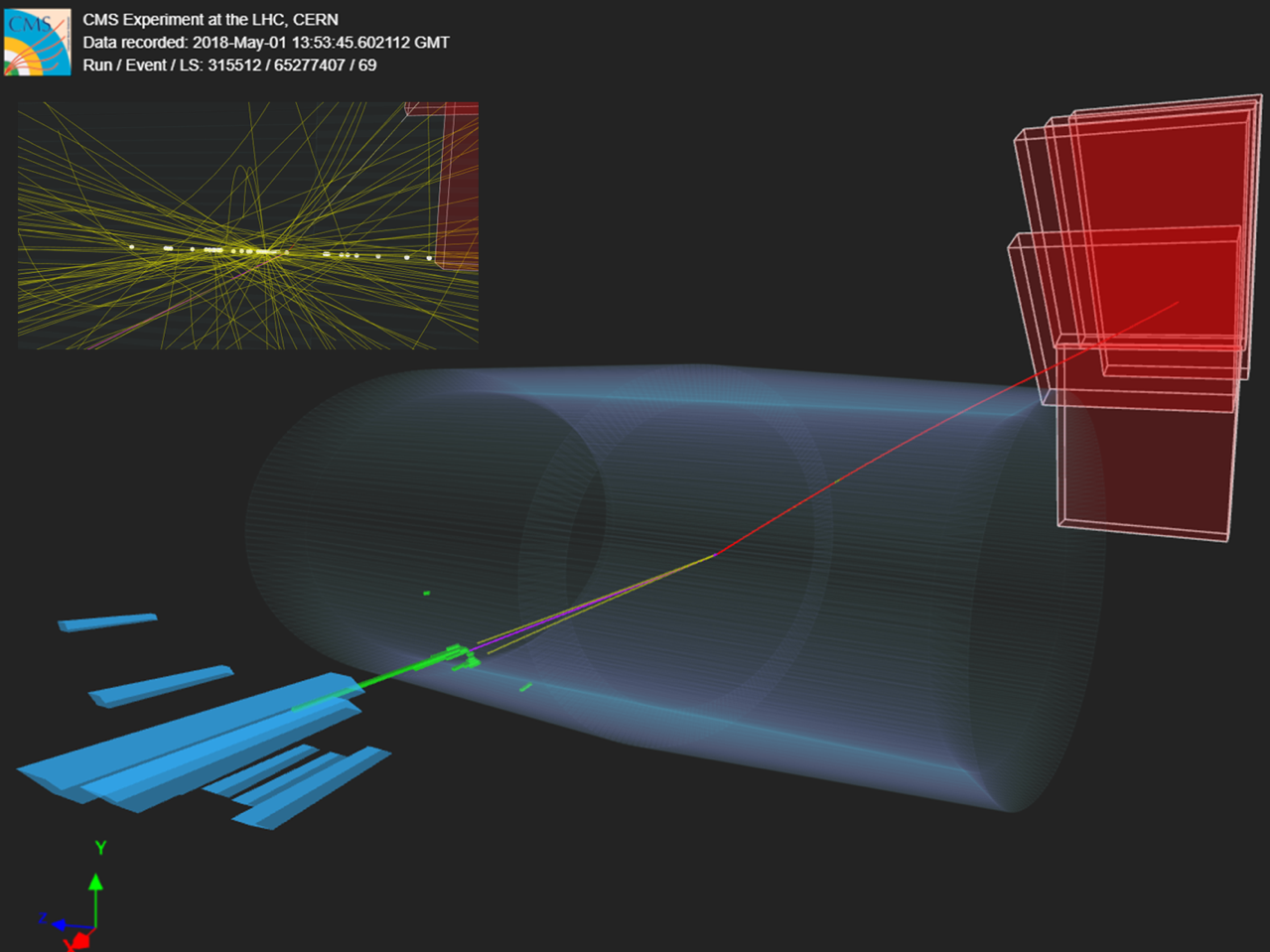The CMS team has reported the discovery of two photons producing two tau leptons in proton-proton collisions. This phenomenon, made feasible by utilizing the CMS detector’s precision tracking capabilities, has never been observed in proton-proton collisions. It provides a novel approach to constrain the presence of new physics and is also the most accurate measurement of the tau's anomalous magnetic moment.
 Recreated candidate event of a γγ →ττ process in proton–proton collisions measured by the CMS detector. The tau can decay into a muon (red), charged pions (yellow) and neutrinos (not visible); energy deposits in the electromagnetic calorimeter in green and in the hadronic calorimeter in cyan. Image Credit: CMS collaboration
Recreated candidate event of a γγ →ττ process in proton–proton collisions measured by the CMS detector. The tau can decay into a muon (red), charged pions (yellow) and neutrinos (not visible); energy deposits in the electromagnetic calorimeter in green and in the hadronic calorimeter in cyan. Image Credit: CMS collaboration
In the family of leptons, the tau, sometimes known as the tauon, is an unusual particle. The “matter” component of the Standard Model (SM) is generally composed of leptons and quarks. It was not until the late 1970s at SLAC that the tau was found, and it was not until 2000 at Fermilab that the DONUT collaboration discovered the tau neutrino, which completed the tangible matter component.
The tau has a relatively limited lifetime—only 290·10–15 s (a hundred quadrillionth of a second) of stability, which makes precise investigation challenging.
The electron and muon, the other two charged leptons, have been examined well. Their magnetic moments and the corresponding anomalous magnetic moments are also well understood. The former could be regarded as the orientation and strength of a hypothetical bar magnet inside a particle.
Nonetheless, this quantifiable amount requires quantum-level adjustments due to virtual particles tugging at the magnetic moment, which causes it to differ from the expected value. The quantum correction, known as the anomalous magnetic moment, is around 0.1%. This anomalous magnetic moment, al, provides access to physics outside the SM if the theoretical and experimental results are at odds.
The anomalous magnetic moment of the electron is one of the most accurately known variables in particle physics, and it corresponds exactly with the SM. Its muonic counterpart, on the other hand, is one of the most extensively studied, with ongoing study. Although theory and experiments have mainly agreed so far, new findings suggest a tension that warrants additional exploration.
For the tau, the race is still ongoing. The tau's short duration makes measuring its anomalous magnetic moment, aτ, particularly challenging. The earliest attempts to quantify aτ following the tau’s discovery resulted in an uncertainty that was 30 times larger than the quantum corrections. Experimental work at CERN using the LEP and LHC detectors enhanced the restrictions, decreasing uncertainties to 20 times the magnitude of the quantum corrections.
In collisions, researchers hunt for a unique process: two photons interacting to form two tau leptons, also known as a di-tau pair, which decay into muons, electrons, charged pions, and neutrinos. So far, ATLAS and CMS have seen this in ultra-peripheral lead-lead collisions. CMS now reports the first detection of the same mechanism occurring during proton-proton collisions.
These collisions provide more sensitivity to physics outside the SM because novel physics effects rise with collision energy. Using the CMS detector’s exceptional tracking capabilities, the cooperation was able to isolate this unique process from others by selecting events where taus are created without any other track within distances as tiny as 1 mm.
This remarkable achievement of detecting ultra-peripheral proton–proton collisions set the stage for many groundbreaking measurements of this kind with the CMS experiment.
Michael Pitt, CMS Collaboration
The CMS collaboration tried out this novel approach right away, as it provides an innovative technique to restrict the tau anomalous magnetic moment. Future run data will enhance the relevance; nonetheless, their initial measurement imposes the strictest limitations so far with unprecedented precision. It lowers the prediction uncertainty to only three times the quantum correction size.
It is truly exciting that we can finally narrow down some of the basic properties of the elusive tau lepton.
Izaak Neutelings, CMS Collaboration
Xuelong Qin, another member of the analysis team, added, “This analysis introduces a novel approach to probe tau g-2 and revitalizes measurements that have remained stagnant for more than two decades.”